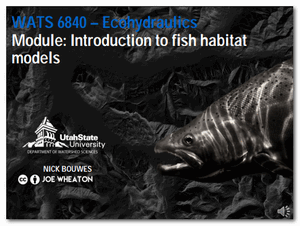Background
Net energy intake (NEI) or net rate energy intake (NREI: synonymous) models incorporate optimal foraging theory with bioenergetics models to describe habitat quality. Because the model is mechanistic it performs well in multiple settings, and is thus more robust and realistic than traditional habitat suitability models. While NREI can be measured directly in the field, when combined with hydraulic models, the approach is powerful for evaluating different restoration and management scenarios (e.g. flow regulation, channel reconfiguration, nutrient additions, etc.). Along with rules on territoriality, this model can also be used to estimate carrying capacity of a reach. We have focused on channel morphology, hydraulics, temperature, and food availability as means to describe habitat quality and quantity. NREI models uses all these variables in a logical mechanistic fashion. Because of their ability to evaluate multiple scenarios and to predict carrying capacity (a major input to life-cycle models) this approach was a very appealing means to address ESA strategies in ISEMP and CHaMP, a thus a key ecohydraulic model for this class.
Lectures and slides
Net rate of energy (NREI) Models Intro Lecture
41 minutesNet rate of energy (NREI) as an Ecohydraulic model
40 minutesReading
We will primarily discuss:
-
Rosenfeld JS, Bouwes N, Wall CE, Naman SM. 2014. Successes, failures, and opportunities in the practical application of drift-foraging models. Environmental Biology of Fishes 97 : 551–574. DOI: 10.1007/s10641-013-0195-6. PDF
-
Wall CE, Bouwes N, Wheaton JM, Bennett SN, Saunders WC, McHugh PA, Jordan CE. 2017. Design and monitoring of woody structures and their benefits to juvenile steelhead ( Oncorhynchus mykiss ) using a net rate of energy intake model. Canadian Journal of Fisheries and Aquatic Sciences 74 : 727–738. DOI: 10.1139/cjfas-2016-0131 . PDF
For further reference:
- Hayes JW, Hughes NF, Kelly LH. 2007. Process-based modelling of invertebrate drift transport, net energy intake and reach carrying capacity for drift-feeding salmonids. Ecological Modelling 207 : 171–188. DOI: 10.1016/j.ecolmodel.2007.04.032. PDF
- C. Eric Wall, Nicolaas Bouwes, Joseph M. Wheaton, W. Carl Saunders, and Stephen N. Bennett. Net rate of energy intake predicts reach-level steelhead (Oncorhynchus mykiss) densities in diverse basins from a large monitoring program. Canadian Journal of Fisheries and Aquatic Sciences. 73(7): 1081-1091. https://doi.org/10.1139/cjfas-2015-0290
